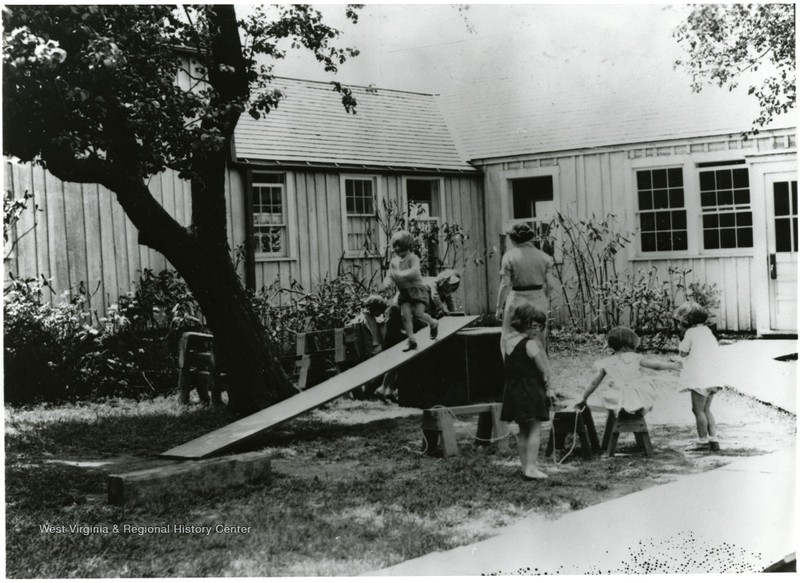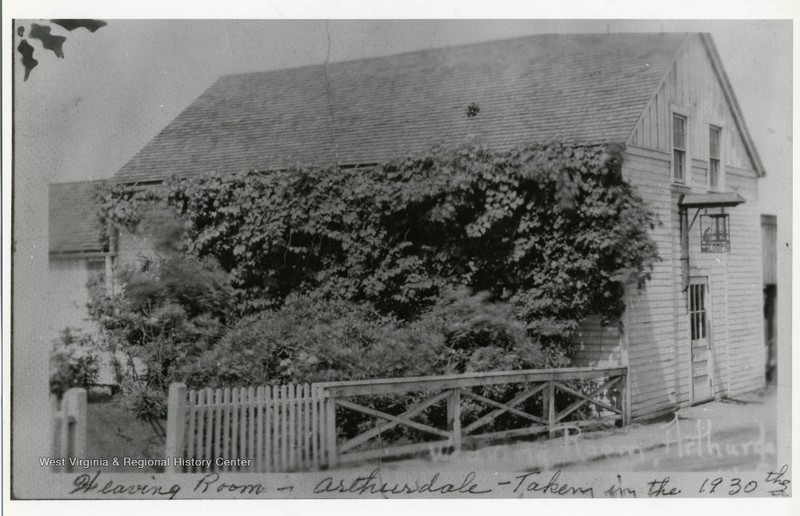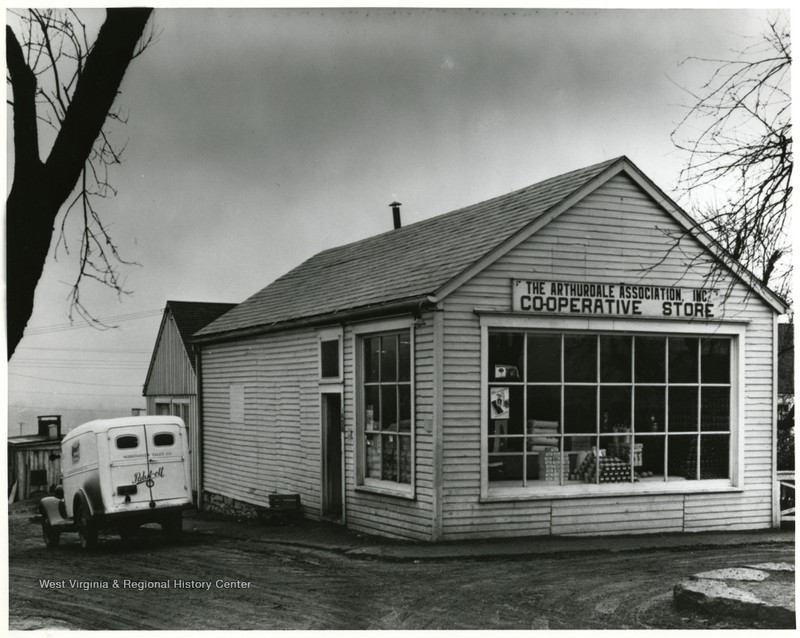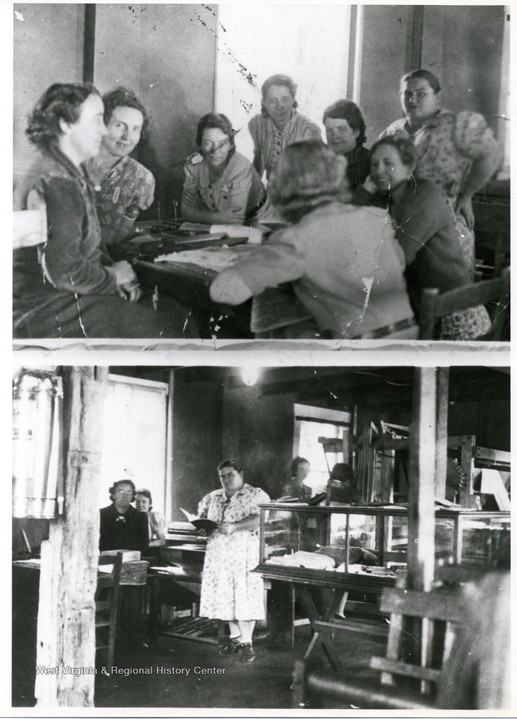Ruins at Center Hall
Introduction
Text-to-speech Audio
Here, several buildings once stood that were important fixtures in the Arthurdale community. A general store, nursery school, tea room, weaving studio, and furniture factory building all existed in this space. These businesses were part of the Arthurdale Association, a non-share corporation and branch of the Mountaineer Craftmen’s Cooperative Association operating in Scotts Run. The association took out loans for several cooperative ventures in Arthurdale including a store, farm, inn, a barber shop, industrial factory, and service station, as well as a dairy and poultry operation.
Images
Former Nursery School

Former Weaving Room

Former Co-operative General Store

Former Weaving Room Interior

Backstory and Context
Text-to-speech Audio
On October 22, 1935, the homesteaders in Arthurdale chartered the Arthurdale Association, which took out loans to establish the cooperative businesses in Arthurdale, including all those at Center Hall. All of the co-ops lost money for the association. Historian Steven Haid stated that the cooperatives “were poorly conceived, poorly managed, and…poorly operated.” Although financially unsuccessful, the cooperatives did provide employment to the homesteaders at a time when it was most needed as well as skills they used even after the craft industry stopped operations.
The Arthurdale Unit of the Mountaineer Craftsman Cooperative began in 1935, as a collective of manufacturing concerns which exemplified the trade skills of the homesteaders of Arthurdale. They manufactured furniture, pewter, copper, and woven goods. The cooperative in Arthurdale was an outgrowth of the efforts of the American Friends Service Committee.
The most successful of the craft ventures was the furniture. In addition to making the simple furniture which was provided for and purchased by the homesteaders, the furniture factory produced 3 minor lines and 4 major lines of furniture, from the more simple to the more ornate, the 500, 700, 800, and 900 series. This furniture was sold to furniture stores or directly to the public. Many pieces are still in use today around the United States and there are several pieces in Eleanor Roosevelt’s Val-Kill Cottage. However, due to years of low profits, the furniture factory along with the Arthurdale branch of the MCCA closed before the other co-operatives in town.
In 1934, with five looms from Scotts Run and nine additional looms purchased by Eleanor Roosevelt, the spinning and weaving cooperative in Arthurdale began. Mrs. Roosevelt also paid for teachers from Berea College in Kentucky to teach interested women to weave. The cooperative produced rag rugs, coverlets, aprons, pillow tops, tablecloths, draperies, bedspreads, and clothes out of linen, cotton, and wool. Most of these items sold commercially through the Craft Shop, but the cooperative also filled orders from all over the United States and other countries. The women also quilted blankets and donated them to the Health Center and Nursery School.
The community interest in weaving was so high that a course was offered at the high school for junior and senior girls. In 1939, Eleanor Roosevelt paid for Arthurdale High School graduate Dorothy Mayor Thompson to study weaving in Louisville, Kentucky, with master weaver Lou Tate for 18 months.
One of the important factors in the success of Arthurdale, was to be the creation of employment for homesteaders in a factory that would be built. As early as October 1933, the administration began looking at options for the factory and eventually built a factory in 1935. In January 1936, the Arthurdale Association purchased the factory building to house a vacuum cleaner factory. The 1930s proved difficult for business retention in the factory at Arthurdale. From 1936 to 1942, four different businesses operated in the Arthurdale factory buildings including the Electric Vacuum Cleaner Company (1936-1937), the Phillip-Jones Shirt Company (1937-1938), the American Cooperatives, Inc. tractor factory (1939-1940), and the Brunswick Radio and Television Company (1941-1942). During World War II, Silman Manufacturing and Ballard Aircraft Company provided employment for homesteaders in their respective war-related factories. Both companies closed at the end of the war.
Sources
Arthurdale Heritage, Preserving Arthurdale, WV – Eleanor Roosevelt's New Deal Community. Arthurdale Heritage Inc.. Accessed March 20, 2017. http://www.arthurdaleheritage.org/.
Haid, Stephen Edward. "Arthurdale: An Experiment in Community Planning, 1933-1947." Master's thesis, West Virginia University, 1975.
Maloney, C. J. Back to the Land: Arthurdale, FDRs New Deal, and the Costs of Economic Planning. John Wiley & Sons, 2013.
Patterson, Stuart. “A New Pattern of Life: The Public Past and Present of Two New Deal Communities.” Doctoral Thesis, Emory University, 2006.
Penix, Amanda Griffith. Images of America: Arthurdale. Arcadia Publishing, 2007.
Rymer, Jeanne. “Arthurdale, a Social Experiment in the 1930s: Foundations, Fantasies, Furniture, and Failures.” West Virginia History Volume XLVI, 1985-6. Pgs. 89-102.
Ward, Bryan. A New Deal for America. Arthurdale Heritage Inc., 1995
